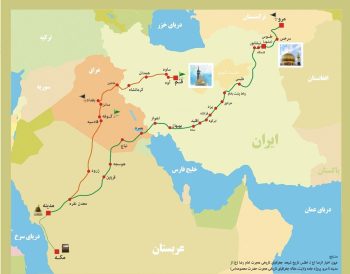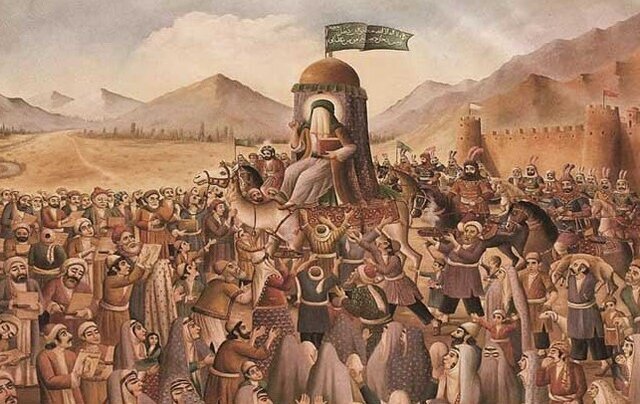How did Imam Reza (a.s.) travel from Madinah to Merv (i.e., the seat of Mamun’s government)? Report Missionary thought and culture baseWe have examined the geography of the eighth Imam’s movement. Although there are differences of opinion regarding the route of Imam Reza’s journey from Medina to Merv, but in this speech, an attempt has been made to examine the route on which most historical sources agree.
The path that Mamun emphasized
The route that Mamun insisted on for Hazrat Reza to pass was one of the common routes of that time, and it was from Madinah to Basra and through Souq al-Ahwaz (Ahwaz) to Fars and then through the desert and the desert between the states of Fars. And it passed Khorasan and ended in Merv.
The path that was common at that time
Another way that was common at that time was going from Madinah to Kufa and Madinah al-Islam (Baghdad) and then from there to Ray, Qom and Khorasan and finally to Marv.
In the criticism of the second route, we can mention this: passing through the three cities of Kufa, Baghdad and Qom; Of these three cities, Kufa and Qom were the center of gathering of Shiites at the beginning of the third Islamic century, and Imam Reza’s passing through these two cities could lead to the strength of Shiites in these areas and their possible rebellion.
The third path, the path of Baghdad, where they were angry with Imam Reza’s oath of office
The third city is Baghdad and the center of gathering and power of the Abbasids, who were angry with Imam Reza’s fiefdom and considered it a transfer of power from the Abbasid family to the Ali family, so in both cases, this path and its choice was to the detriment of Mamun. Rational and logical reasons in addition to the reasons and
When Imam Reza chose the path suggested by Mamun
Historical documents are the first priority. Therefore, the route that Mamun had chosen to transfer Imam Reza from Medina to Merv was very calculated and precise from the point of view of natural, social, political and religious geography.

Imam Reza’s journey from Medina to Merv can be divided into the following 5 stages:
1- From Medina to Basra
2- From Basra to Fars
3- From Fars to Yazd
4- From Yazd to Khorasan
5- Imam in Khorasan
1- From Medina to Basra:
Two of Mamun’s agents named Raja Bin Dahhak and Yasarkhadam were responsible for transferring the Imam from Medina to his seat of government along with a letter. Raja bin Dahhak and Yasarkhadam went to Imam’s house and handed Mamun’s letter to Imam. The Imam did not say a word to Mamun’s envoys and read the letter with disgust, and he inevitably accepted Mamun’s proposal and prepared to travel. In the first step before starting the journey to Merv, the Imam took steps that revealed the nature of accepting the covenantal governorship. Imam Reza (a.s.) took actions such as bidding farewell to the sacred shrine of the Holy Prophet, appointing a successor and announcing the Imamate of Imam Javad (a.s.) and bidding farewell to his family, showing that the promised governorship is a beautiful and luxurious appearance on the face of exile and negation.
Primary sources and other authentic chronicles have mentioned the beginning of Imam Reza’s movement from Medina to Basra. However, some sources, especially the later tazkirahs, write: Hazrat first went to Mecca and Imam Javad accompanied him on this trip, Imam said goodbye to God’s house and then continued his journey from Mecca.
The reports of various sources about Imam Reza’s journey from Medina to Mecca and then to Basra are contradictory and unclear. Some have seen Imam Javad with their noble father in Mecca. It tells about the uncertain and inconsistent nature of Imam Reza’s trip to Mecca. In addition, the situation in Makkah was not very calm at that time, so Imam Reza’s trip to Makkah… is politically contrary to Mamun’s policy and his order to his emissaries. For this reason, Imam Reza’s journey from Medina to Mecca and then to Merv cannot be considered as having clear historical evidence, and it is most likely to be believed that Imam Reza did not travel to Mecca during his journey from Medina to Merv. During his journey to Basra, the Imam stops in Benaj (Brozen Kitab), which is in 6 houses of Basra, and after being welcomed by the Shiites of that region, he leaves for Basra.
2- From Basra to Fars
– From Basra to Souq Al Ahvaz:
There are two ways from Arab country (Iraq) to Khuzestan, one from Baghdad to Wasit and from Wasit to Khuzestan and the other way from Basra to Khuzestan, which was considered the shortest way and distance between Iran and Iraq at that time.
Basra-Ahvaz road was 9 manzils and thirty-six farsangs at that time, but there are no traces of the old names of the menzils of this route in today’s maps, so it is difficult to determine the route of Imam’s movement. Imam Reza moved from Basra to Ahvaz, but the sources did not report the details of the Imam’s route and the places where he stopped.”
When Imam Reza arrived in Ahvaz, the Imam’s illness occurred, and sources say that the reason for the Imam’s illness was the very hot and humid weather of this city, so it can be concluded that the Imam’s journey took place in the summer.
There are three mausoleums named after Imam Reza in Shushtar, two mausoleums named after Shahrasun (Shah Khorasan) in Dezful and Shushtar, and two other mausoleums named after Imam Zaman, which should be looked at critically. These buildings (Imam Reza memorial), which number nearly ten buildings, although in terms of number, they strengthen the passing of Imam Reza in these two cities, but in terms of validity, they are shaky and ambiguous. The three mausoleums of Imam Reza Demi in Shushtar, which the common people consider to be the resting place of Hazrat Reza, have no evidence, according to Sharafuddin Shushtri… Shahrasun’s mausoleum in Dezful is also ambiguous.
Local dates do not confirm Imam’s visit to these two cities. Also, according to the map and the geographical location of Shushtar and Dezful, the passage of Hazrat Reza from these two cities is far from reality, because the Imam must have walked back to Shushtar and then went to Dezful, which does not make this journey rational.
– From Ahvaz to Fars:
About the continuation of Imam Ali bin Musa al-Reza’s journey to Fars, the sources do not explain which way he left for Fars and from there to Khorasan. And we can only get or guess the details of the path of His Holiness and the houses in between by connecting the clear geographical points mentioned in the sources, because the route from Khuzestan to Fars is not limited to one way. From Ahvaz to Fars, there were 24 houses and a total of 102 farsangs.” It is possible that the Holy Prophet may have passed Mehramuz during his historical trip to Marv on the way of Arjan, because we have reports of his passage at the beginning and middle of this road. .
About the Imam’s departure from Ahvaz, there is a detailed report that the Imam crossed the Arbak or Arbak bridge, and this is the key to solving this mystery. Along the way of Arbak Bridge, in the old city of Arjan (Behbahan), there is a footpath known as Imam Reza Footpath. The existence of this footpath in this place illuminates the path of Imam Ali bin Musa al-Reza. The next stop, which is alternately mentioned in local history sources, is the city of Abarqo or Abarkoh, which is at the end of the northern road from Shiraz to Yazd.
Historical sources inform that Imam Reza went to Khorasan from Ahvaz through Fars and not Shiraz. There is no reliable report on the arrival of Hazrat Ali bin Musa al-Reza to Shiraz, and in the local sources of the history of this city, there is never a monument or monument attributed to him. This issue strengthens the possibility of Hazrat Reza passing through the ancient road of Ahvaz to Pasargad, which after Arjan joined the Maroodasht Istakhar plain through the mountain roads of the Kekiloyeh region.
3- From Fars to Yazd:
Ibn Balkhi mentioned 9 houses from Shiraz to Yazd and the distance between these two cities is 54 farsangs. In those days, Yazd was not an important city as it is today, which was a function of Istakhar city. In this area, there are several footpaths and monuments of Imam Reza (a.s.). According to the sources’ emphasis on the passing of that Imam through the desert road to Merv, the credibility of these footpaths is increased. However, as it was said, Yazd was not a city but a desert region in the second Islamic century, so there is no explicit mention of Hazrat Reza’s passing through Yazd in the primary sources, and only the mention of his passing through a desert or desert is mentioned. are
Some believe that Imam Reza entered the city of Qom on the way and stayed in the house of one of the residents of this city, which is now known as the Razaviyeh School or Missionary School. But it must be acknowledged that Mamun had forbidden the Imam to pass through the cities where the Shiites gather. Therefore, the Imam’s presence in this city does not have a strong document. On the other hand, the local history sources do not confirm the presence of the Imam in Qom. The history of Qom, which is one of the oldest sources of local history (378 A.H. Hassan Qomi), does not provide any information about Hazrat Reza’s passing through the city of Qom. Kilini also writes in Usul Kafi: Mamun moved that Prophet from Basra and Shiraz (which had fewer Shiites) to Merv…
4- From Yazd to Khorasan
In general, it is difficult to determine the exact route of Imam Reza’s journey due to the numerous and sometimes contradictory reports of the sources. In this context, it is difficult to determine the route of Imam Reza from Yazd to Khorasan. The only clear point that can be found in this route from the primary sources is the reference that Sheikh Sadouq and other reliable sources have made to the path of the desert road and his arrival in Neishabur.
According to the map, there are signs of Imam Reza passing through these areas in Farang and Rabat behind Badam. Some believe that the Imam went from Rabat Posht Badam to Damghan and then to Neishabur (the blue and then yellow route) and some sources believe that the Imam entered Neishabur by passing through the eastern side of Koirlot. Damghan is geographically located in the route of Hazrat Reza’s movement, it seems probable that he passed through this area.
5- Imam in Khorasan:
Fortunately, there are numerous and documented reports of Imam Reza’s arrival in Neishabur, especially the hadith of the Zahab dynasty, which the Imam objected to in this city, has added to the strength of the reports of Imam’s arrival in Neishabur. The most important and the most reliable report recorded about Hazrat Reza’s stay in Neishabur. It is narrated by Abdus Salam bin Saleh Abu Salat Heravi, who narrates the famous hadith of the Golden Dynasty from Imam Reza in Neishabur.
The Kohlan spring, where the imam bathed and stood in prayer next to its pond, as well as the Neishabur footpath, 24 km from that city, are documented and substantiated memories of Imam Reza’s presence in this city. It should be noted that at that time Neishabur was considered one of the prosperous and large cities of Khorasan and was called Abarshahr, so it is not unlikely that the current location of Neishabur’s footpath, which is now located on the road of Neishabur to Mashhad, was in the city of Neishabur itself at that time. or was in its suburbs. After Neishabur, Imam Reza traveled to Tus, Deh Sarkh and Kouh Sangi. The famous stories among the people of this area speak for the Imam’s presence in this area.
In order to obtain water for ablution, the Imam dug a little in the ground with his hands, and a spring that still exists is boiling.
In Kouh Sangi, Imam Barkat asks for the blessings of the stones of this area, from which they used to carve pots and stone vessels, and this occupation is still present in this area even today.
The warm welcome of the people of Neyshabur to the imam causes Mamun to order the imprisonment of the imam in Sarkhas. Maybe in this way it will make it impossible for the imam to contact the people. Sarkhas is the last city before Marv or the destination of the movement. In the city of Marv, Imam Reza (a.s.) was welcomed by the people and the inhabitants of that city, despite the obvious rule of Mammon, and it was in this city that he inevitably accepted the covenantal governorship of Mammon and gave them to Zoharkin. The family of Siah Jammeh and Siah Dil Bani Abbas are martyred.
This journey should truly be considered a journey of sorrow, Imam Reza (a.s.) was called from Madinah al-Nabi by Mamun’s conspiracy, and by submitting to the will of God and being satisfied with his pleasure, the Imam earned the title of Rezai for the family of Muhammad (pbuh); Now, Mashhad al-Reza is the Qiblah of every Iranian Muslim. Although the Imam’s journey to Marv was a journey full of sorrow, although it made the Imam far away from the presence of the Prophet, but now Imam Reza (a.s.) circumambulates day and night in a circle of his lovers. And if it wasn’t for Mashhadal Reza, Iran would be empty of a beating heart and a living heart. The suffering of God’s men only has the appearance of suffering, but there is a lot of goodness hidden inside that we are witnessing, without any exaggeration we can say that everything we have is due to the blessing of Imam Reza, who spread his blessed hand over us in his Mashhad.
منبع: www.khabaronline.ir




